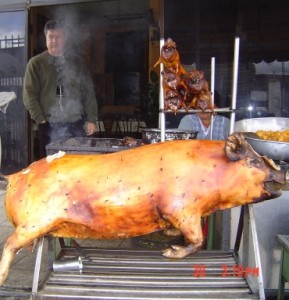This release is being reissued to expand the August 13, 2015 recall to include additional products. Details of this release were also updated to reflect a change in poundage, epidemiological informational and distribution area.
 Kapowsin Meats, a Graham, Wash. establishment, is recalling approximately 523,380 pounds of pork products that may be contaminated with Salmonella I 4,[5],12:i:-, the U.S. Department of Agriculture’s Food Safety and Inspection Service (FSIS) announced today.
Kapowsin Meats, a Graham, Wash. establishment, is recalling approximately 523,380 pounds of pork products that may be contaminated with Salmonella I 4,[5],12:i:-, the U.S. Department of Agriculture’s Food Safety and Inspection Service (FSIS) announced today.
FSIS has been conducting intensified sampling at Kapowsin Meats while this establishment took steps to address sanitary conditions at their facility after the original recall on August 13, 2015. Sampling revealed positive results for Salmonella I 4,[5],12:i:- on Whole Hogs for Barbeque, associated pork products and throughout the establishment. FSIS has deemed sanitary improvement efforts made by the Kapowsin Meats insufficient, and the scope of this recall has been expanded to include all products associated with contaminated source material. The establishment has voluntarily suspended operations.
The whole hogs and associated items were produced on various dates between April 18, 2015 and August 26, 2015. The following products are subject to recall:
Varying weights of boxed/bagged Whole Hogs for Barbeque
Varying weights of boxed/bagged fabricated pork products including various pork offal products, pork blood and pork trim.
The product subject to recall bears the establishment number “Est. 1628” inside the USDA mark of inspection. The product was shipped to various individuals, retail locations, institutions, and distributors in Alaska, Oregon and Washington.
On July 15, 2015, the Washington State Department of Health notified FSIS of an investigation of Salmonella I 4,[5],12:i:- illnesses. Working in conjunction with the Washington State Department of Health and the Centers for Disease Control and Prevention (CDC), FSIS determined that there is a link between whole hogs for barbeque and pork products from Kapowsin Meats and these illnesses. Traceback investigation has identified 36 case-patients who consumed whole hogs for barbeque or pork products from this establishment prior to illness onset. These illnesses are part of a larger illness investigation. Based on epidemiological evidence, 152 case-patients have been identified in Washington with illness onset dates ranging from April 25, 2015 to August 12, 2015. FSIS continues to work with our public health partners on this ongoing investigation.
 Consumption of food contaminated with Salmonella can cause salmonellosis, one of the most common bacterial foodborne illnesses. The most common symptoms of salmonellosis are diarrhea, abdominal cramps, and fever within 12 to 72 hours after eating the contaminated product. The illness usually lasts 4 to 7 days. Most people recover without treatment. In some persons, however, the diarrhea may be so severe that the patient needs to be hospitalized. Older adults, infants, and persons with weakened immune systems are more likely to develop a severe illness. Individuals concerned about an illness should contact their health care provider.
Consumption of food contaminated with Salmonella can cause salmonellosis, one of the most common bacterial foodborne illnesses. The most common symptoms of salmonellosis are diarrhea, abdominal cramps, and fever within 12 to 72 hours after eating the contaminated product. The illness usually lasts 4 to 7 days. Most people recover without treatment. In some persons, however, the diarrhea may be so severe that the patient needs to be hospitalized. Older adults, infants, and persons with weakened immune systems are more likely to develop a severe illness. Individuals concerned about an illness should contact their health care provider.
FSIS and the company are concerned that some product may be frozen and in consumers’ freezers. Consumers who have purchased these products are urged not to consume them, and should throw them away or return the products to the place of purchase.
FSIS routinely conducts recall effectiveness checks to verify recalling firms notify their customers of the recall and that steps are taken to make certain that the product is no longer available to consumers. When available, the retail distribution list(s) will be posted on the FSIS website at www.fsis.usda.gov/recalls.
FSIS advises all consumers to safely prepare their raw meat products, including fresh and frozen, and only consume pork and whole hogs for barbeque that have been cooked to a minimum internal temperature of 145° F with a three minute rest time. The only way to confirm that whole hogs for barbeque are cooked to a temperature high enough to kill harmful bacteria is to use a food thermometer that measures internal temperature, http://1.usa.gov/1cDxcDQ. For whole hogs for barbeque make sure to check the internal temperature with a food thermometer in several places. Check the temperature frequently and replenish wood or coals to make sure the fire stays hot. Remove only enough meat from the carcass as you can serve within 1-2 hours.
Media and consumers with questions regarding the recall can contact John Anderson, Owner, at (253) 847-1777.
Consumers with food safety questions can “Ask Karen,” the FSIS virtual representative available 24 hours a day at AskKaren.gov or via smartphone at m.askkaren.gov. The toll-free USDA Meat and Poultry Hotline 1-888-MPHotline (1-888-674-6854) is available in English and Spanish and can be reached from l0 a.m. to 4 p.m. (Eastern Time) Monday through Friday. Recorded food safety messages are available 24 hours a day. The online Electronic Consumer Complaint Monitoring System can be accessed 24 hours a day at: http://www.fsis.usda.gov/reportproblem.








 avoid eating around animals as they attend county and state fairs.
avoid eating around animals as they attend county and state fairs. minute diatribe about what an awful band Journey was., but, here it is, in all its boredom.
minute diatribe about what an awful band Journey was., but, here it is, in all its boredom..jpg) further nine lettuce mixes from the market. The Norwegian Food Safety Authority recommends that consumers should not eat these lettuce mixes. The Norwegian Institute of Public Health is continuing the investigation in co-operation with the Food Safety Authority and Veterinary Institute.
further nine lettuce mixes from the market. The Norwegian Food Safety Authority recommends that consumers should not eat these lettuce mixes. The Norwegian Institute of Public Health is continuing the investigation in co-operation with the Food Safety Authority and Veterinary Institute.  believed to have rooted beneath bat colonies in trees, eating food contaminated by droppings. But the Bangladesh outbreak happened without a swine vector.
believed to have rooted beneath bat colonies in trees, eating food contaminated by droppings. But the Bangladesh outbreak happened without a swine vector.